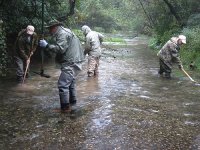Dave_W
Moderator
Staff member
Back in the 1960s and 70s, Charlie Fox was keenly interested in the problem of where and how trout spawned in spring creeks, his beloved Letort in particular. Since such limestoners often lacked good areas with gravel, Fox started importing truck loads of stones into Letort in its upper reaches and down by his house. Over the years, Fox and the volunteers from Cumberland Valley Trout Unlimited (CVTU) have added improvements and carefully watched over these essentially man made spawning areas. Earlier today, CVTU volunteers conducted our annual rake and maintenance of these gravel areas. This is done in September before trout start moving up into these sections. The purpose is to clear accumulated sediment and generally stir up the rocks and break 'em out of embedded stream bottom thus making them easier for redd building browns to manipulate during the spawn. Invasive weeds were also pulled to keep the channel flows clear. Not only do trout spawn here, but large numbers of white suckers some years as well.




